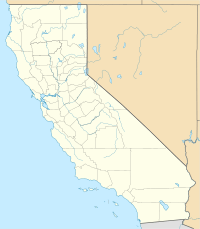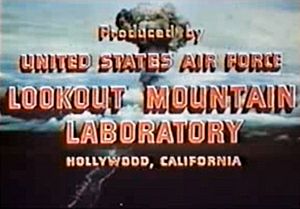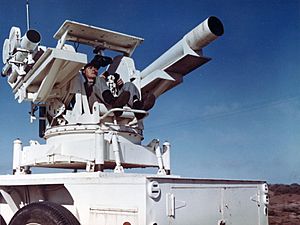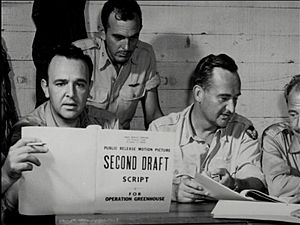Lookout Mountain Air Force Station facts for kids
Quick facts for kids Lookout Mountain Air Force Station
|
|
|---|---|
| Part of Military Airlift Command (MAC) | |
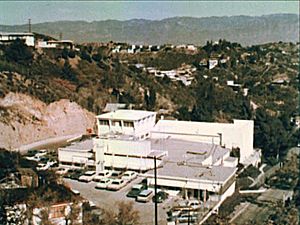
Lookout Mountain Laboratory Air Force Station from above
|
|
|
Location of Lookout Mountain AFS, California
|
|
| Coordinates | 34°06′32″N 118°23′19″W / 34.108810°N 118.388588°W |
| Type | Air Force Station |
| Site information | |
| Owner | Jared Leto |
| Controlled by | |
| Site history | |
| Built | 1941 |
| In use | 1947–1969 |
| Garrison information | |
| Garrison | 1352d Photographic Group |
Lookout Mountain Air Force Station (LMAFS) was a secret United States Air Force base. It was located in the Laurel Canyon area of Los Angeles, California. From 1947 to 1969, this base made movies and photos for the United States Department of Defense and the Atomic Energy Commission (AEC).
The facility was built in 1941 during World War II. It was first used to help control air defense for Los Angeles. When it became a film studio in 1947, its purpose was kept secret. The studio was very large, with a sound stage, film labs, screening rooms, and editing rooms. It had the best equipment to process both movie and still photos. In 2015, it was named a Los Angeles Historic-Cultural Monument. Today, it is a private home owned by actor Jared Leto.
Contents
Filming Nuclear Tests (1947–1960)
After the first nuclear test, called Trinity, in 1945, there was a clear need to record these events. Photos and films helped scientists study how nuclear weapons behaved. In 1946, a special photography team documented Operation Crossroads, the first atomic bomb test in the Pacific.
After this test, it was decided that a permanent photo unit was needed. This unit would specialize in filming and recording sound for future atomic bomb tests. General P.T. Cullen, who led the photo unit for Operation Crossroads, was asked to find a suitable location in Los Angeles.
He chose an Air Force building at 8935 Wonderland Avenue. This building was originally built in 1943 for air traffic control. After World War II, it was no longer needed by the Air Force. In late 1947, the 1352d Motion Picture Squadron started working at Lookout Mountain.
In 1948, the Air Force and the Atomic Energy Commission took over the building. They called it the Lookout Mountain Laboratory. It was greatly remodeled, with new fireproof vaults to store millions of feet of film. New equipment was brought in from other Air Force units.
During this time, the lab was focused on supporting nuclear tests. Its staff included officers from different military branches and civilian photographers. Their salaries were paid by both the AEC and the Air Force.
In 1949, the lab and its staff were moved under the command of the Air Proving Ground. They were given the important job of filming all documentary photography for Joint Task Force 3 and Operation Greenhouse. This was the first time a photo unit was involved in planning a nuclear test from the very beginning.
More construction happened at Lookout Mountain Laboratory between 1950 and 1953. A new, large building was constructed, much of it underground. New film processing equipment, more film vaults, and a sound stage were added. The AEC was allowed to store all its nuclear test films there for free. By 1953, the new facility was worth about $1.5 million.
The 1352nd Motion Picture Squadron
On April 1, 1951, the Air Force created the Air Pictorial Service (APS). The main photo unit was the 4881st Motion Picture Squadron. All photography of atomic bomb tests was quickly moved to this new service.
The Air Pictorial Service was later renamed the Air Photographic and Charting Service (APCS) in 1952. APCS was responsible for mapping the world and creating accurate aerial charts for military pilots. It also made all Air Force training films and newsreels. On May 1, 1952, the 4881st Motion Picture Squadron became the 1352nd Motion Picture Squadron.
The main job of this new squadron was to produce secret films and photos for the Air Force. This work supported the Atomic Energy program. They also created other films and photos as directed by the Air Pictorial Service.
Later Years (1958–1969)
In March 1958, Lookout Mountain Laboratory was renamed Lookout Mountain Air Force Station.
On July 1, 1960, the 1352d Motion Picture Squadron became the 1352d Photographic Group. Its main office was at Lookout Mountain Air Force Station. Other offices for administration and personnel were located in North Hollywood.
In 1966, the Military Air Transport Service became the Military Airlift Command (MAC). The Air Photographic and Charting Service became the Aerospace Audio Visual Service (AAVS).
By March 1967, the 1352nd Photographic Group had two squadrons and several smaller units. These units were located in places like Vandenberg Air Force Base, California, Tan Son Nhut Air Base in South Vietnam, Colorado Springs, and Hickam Air Force Base, Hawaii.
From 1960 to 1969, the 1352d Photo Group was in charge of all documentary photography. They also maintained labs and production facilities in the western United States, the Pacific, and the Far East.
Films Produced
Each year, Lookout Mountain produced about 35 to 40 finished films. A "reel" was about 10 minutes of film. They also provided footage for the monthly Air Force Newsreel, which was shown to Air Force personnel worldwide. They sent unclassified film clips to TV media, showing Air Force combat operations in Vietnam.
Many of the films featured famous Hollywood actors and narrators. Some stars who worked on films at "the Hill," as the studio was called, included:
- Bob Hope
- Jimmy Stewart
- Robert Preston
- James Garner
- Gregory Peck
- Kim Novak
- Glenn Ford
- Lee Marvin
Jimmy Stewart, who was also an Air Force Reserve General, narrated several films. He also appeared in public service announcements for the Civil Air Patrol.
Special film projects included:
- ': This film told the story of F-105 pilots bombing targets in North Vietnam.
- USAF Combat Photography In Southeast Asia: This film showed the work of the 600th Photo Squadron. They documented Air Force operations in South Vietnam.
- A Night On Jackrabbit Mesa: This film taught civilian authorities how to handle an Air Force plane crash.
- Escape and Evasion: This film taught pilots how to survive if they were shot down.
For many years, Lookout Mountain Air Force Station helped Bob Hope with his annual Christmas tours to entertain troops in Vietnam. They provided film equipment and crews to document his tours. These tours were later shown on TV as Bob Hope Specials.
The station also supported the AEC by documenting underground nuclear tests. These tests took place at the Nevada Test Site (NTS). From 1951, photographers experimented with different film methods, including high-speed and wide-screen. Nuclear tests were filmed in various formats, including 35mm, 16mm, Cinemascope, VistaVision, and even 3-D. Between 1946 and 1969, the studio made over 6,500 films for the Atomic Energy Commission and other government groups. Many of these films are still secret today.
Talented Staff
In the 1960s, Lookout Mountain Air Force Station had over 250 military and civilian staff. Many talented civilians worked there as producers, writers, directors, cameramen, editors, and animators. Many of these "old timers" had worked at famous Hollywood studios like Warner Bros. and Metro-Goldwyn-Mayer. Many producers and directors were also veterans of World War II film units.
W. Donn Hayes, a famous film editor, worked at Lookout Mountain. He had been in the film industry since 1916. His credits included Rebecca (1940).
Another editor, William "Bill" Holmes, had edited 54 feature films at Warner Bros. He won an Academy Award in 1941 for his editing work on Sergeant York.
Barry Shipman, one of the writers, had written for Universal Pictures. He also wrote for TV shows like Lassie and Death Valley Days.
Vietnam War Documentation (1966–1975)
In 1966, the 1352 Photographic Group took on a new role: documenting the growing war in Vietnam. On February 8, 1966, a unit at Tan Son Nhut Air Base in South Vietnam became the 600th Photo Squadron. This squadron was responsible for all Air Force photography in Southeast Asia, except for reconnaissance photos. Their work included combat documentation, gun-camera footage, and still photography.
Between 1966 and 1976, the 600th Photo Squadron lost 11 combat cameramen who were killed in action. Four of them died in 1968, during the busiest time of U.S. combat operations in Vietnam.
Closing Down
In June 1968, the 1352d Photographic Group at Lookout Mountain Air Force Station was closed. All its staff and equipment were moved to Norton Air Force Base, California. The Air Force's main film storage, which holds over 100 million feet of film, also moved to Norton Air Force Base.
Private Ownership
After it closed, the facility was sold. It was bought at an auction for $50,000. An American Indian producer named Dehl Berti later owned the property. He tried to keep it as a production facility. The sound stage still had maps of planned flight patterns painted on the floor. Some believe this sound stage was used to film a backup moon landing in case the real one failed. Berti started adding a two-story swimming pool that could be seen through glass windows in the old underground film lab.
Berti faced financial difficulties, and the property was taken back by his lender. It was later bought by a computer developer in the mid-1980s for $550,000. This owner finished turning the property into a home. It was sold again in 1994 for $750,000.
For many years, it has been a private home. In 2011, it was listed for sale for over $6 million. At that time, it was a 50,000 square foot home with eight bedrooms on 1.5 acres.
In November 2012, the former Air Force studio was leased by the One80Center as a rehab center. In January 2015, Academy Award-winning actor Jared Leto bought the property for USD$5 million.
Images for kids



